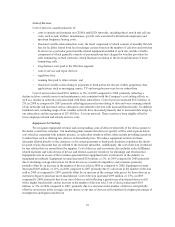Sprint - Nextel 2008 Annual Report Download - page 32
Download and view the complete annual report
Please find page 32 of the 2008 Sprint - Nextel annual report below. You can navigate through the pages in the report by either clicking on the pages listed below, or by using the keyword search tool below to find specific information within the annual report.
In addition to our customer-oriented goals, we have also taken steps to generate operating cash flow and
reduce our cost structure to align with the reduced revenues from fewer post-paid subscribers. Our actions
include workforce reductions in 2009, which are expected to reduce labor and other costs by approximately $1.5
billion annually. We believe these actions, as well as our continued efforts to reduce other operating expenses
and non-essential capital spending, will allow us to maintain a strong cash position, although we do not expect
that these measures will fully offset the decline in cash provided by operating activities expected because of our
lower number of post-paid subscribers as discussed below in “Effects on our Wireless Business of Post-paid
Subscriber Losses.”
Effects on our Wireless Business of Post-paid Subscriber Losses
The following table shows annual net additions (losses) of post-paid subscribers for the past five years,
excluding subscribers obtained through business combinations.
Year Ended December 31,
2009 2008 2007 2006 2005
( in thousands)
Total net additions (losses) of post-paid subscribers ....... (3,546) (4,073) (1,224) 279 2,194
As shown by the table below under “Results of Operations,” Wireless segment earnings represent more
than 80% of Sprint’s total consolidated segment earnings. Within the Wireless segment, post-paid wireless voice
and data services represent the most significant contributors to earnings and are driven by the number of post-
paid subscribers to our services, as well as the average revenue per subscriber or user (ARPU).
Beginning in mid-2006, Sprint began to experience net losses of post-paid subscribers on the iDEN
wireless network, which we acquired in 2005 in the Sprint-Nextel merger. Such net losses for the year ended
December 31, 2007 exceeded the net additions of post-paid subscribers on our CDMA wireless network.
Beginning in 2008 and continuing through 2009, we have been experiencing net losses of post-paid subscribers
on each of the iDEN and CDMA wireless networks, excluding migration of subscribers between networks.
We believe that these significant net post-paid subscriber losses resulted from a number of historical
factors, in addition to the competitive nature of the industry, including: 1) uncertainty in the marketplace as to
our commitment to the iDEN network; 2) a high level of involuntary churn during 2007 and early 2008 due to a
relatively high mix of sub-prime credit subscribers; 3) adverse perceptions among some of our subscribers about
our customer care services; 4) adverse perceptions among some of our subscribers about the quality of and our
commitment to development of our networks; 5) successful competitor devices; 6) perception in the marketplace
that the portfolio of Sprint device offerings was not as desirable as those of some competitors; 7) uncertainty
about the financial strength and future reliability of Sprint; and 8) perceptions in the marketplace, in part as a
result of the subscriber losses themselves, as well as the other factors above, that reduced the Sprint brand’s
effectiveness in attracting and retaining subscribers.
Beginning in 2008, in conjunction with changes in senior management, Sprint undertook steps to
address each of these factors. Before directly addressing brand perception, steps were taken to improve the
quality of Sprint’s customer care services and the Sprint networks, as confirmed by recent independent
comparisons with competitors. Steps were also taken to improve the credit quality mix of our subscriber base and
to improve our financial stability, including vigorous cost control actions, which have resulted in our continuing
strong cash flow from operations. We also improved financial flexibility through renegotiation in 2008 of our
revolving bank credit facility. In addition, beginning in 2008 and continuing in 2009, we have undertaken
increased marketing initiatives, to increase market awareness of the improvements that have been achieved in the
customer experience, including the speed and dependability of our network. We have also introduced new
devices improving our overall lineup and providing a competitive mix for customer selection, as well as
competitive new rate plans providing simplicity and value.
30
























